If you want to be able to cancel part of a graph's execution, you need to use task_group_contexts. Add the following include:
#include "tbb/task.h"
and change your main program to the following:
int main()
{
tbb::task_group_context tgc1;
tbb::task_group_context tgc2;
graph g1(tgc1);
graph g2(tgc2);
printf("Constructing graph\n");
broadcast_node< continue_msg > start(g1);
continue_node<continue_msg> a( g1, body("A"));
continue_node<continue_msg> b( g2, body("B"));
continue_node<continue_msg> c( g2, body("C"));
continue_node<continue_msg> d( g2, body("D"));
continue_node<continue_msg> e( g1, body("E"));
make_edge( start, a );
make_edge( start, b );
make_edge( a, c );
make_edge( b, c );
make_edge( c, d );
make_edge( a, e );
for (int i = 0; i < 3; ++i ) {
try
{
printf("broadcasting graph %d\n", i);
start.try_put( continue_msg() );
g1.wait_for_all();
g2.wait_for_all();
} catch (...)
{ printf("Caught exception\n");
}
g1.wait_for_all();
g1.reset();
g2.reset();
}
return 0;
}
Each task_group_context is a subcontext of the (default) parent context. Cancelling g2 does not affect g1. If B throws instead of cancelling, your catch will ensure the exception is not passed to the parent. If you don't catch the exception, the parent context will also be cancelled, as will the context for A and E.

Notice you have to wait for both graphs to complete. Also you must reset() the graphs to reset the continue_nodes' counters. Actually, in the case where an exception is thrown and caught, there is no guarantee that g1 is complete after the catch(...) is complete, so you need to do a g1.wait_for_all() outside the try/catch. I edited the code to show that.
Instead of using cancellation to stop part of the computation, you could make B a multifunction_node with an input of continue_msg and a single output of a continue_msg:
typedef multifunction_node<continue_msg, tuple<continue_msg> > mf_type;
struct mf_body {
std::string my_name;
mf_body(const char *name) : my_name(name) {}
void operator()(continue_msg, mf_type::output_ports_type &op) {
if(my_name == "B") {
printf("%s returning without sending\n", my_name.c_str());
return;
}
sleep(1);
get<0>(op).try_put(continue_msg());
return;
}
};
Then you create node B:
mf_type b( g, unlimited, mf_body("B"));
and the edge from B to C would be set up like so:
make_edge( output_port<0>(b), c );
In this case you don't need to split the graph into two subgraphs. If node B would have cancelled, instead it returns without forwarding a continue_msg to its successor. If node B does not forward a message, node C will not execute, because it needs two continue_msgs to start. You still need to reset the graph after, to reset C's count.
The multifunction_node has the advantage that you can choose to forward a message or not. The caveat here is that a multifunction_node with a continue_msg input is not like a continue_node. The continue_node needs as many continue_msgs as it has predecessors (plus the initialization value on construction.) The multifunction_node body is executed when it receives a continue_msg, no matter how many predecessors it has. So for your graph you cannot just make all the nodes multifunction_nodes.
